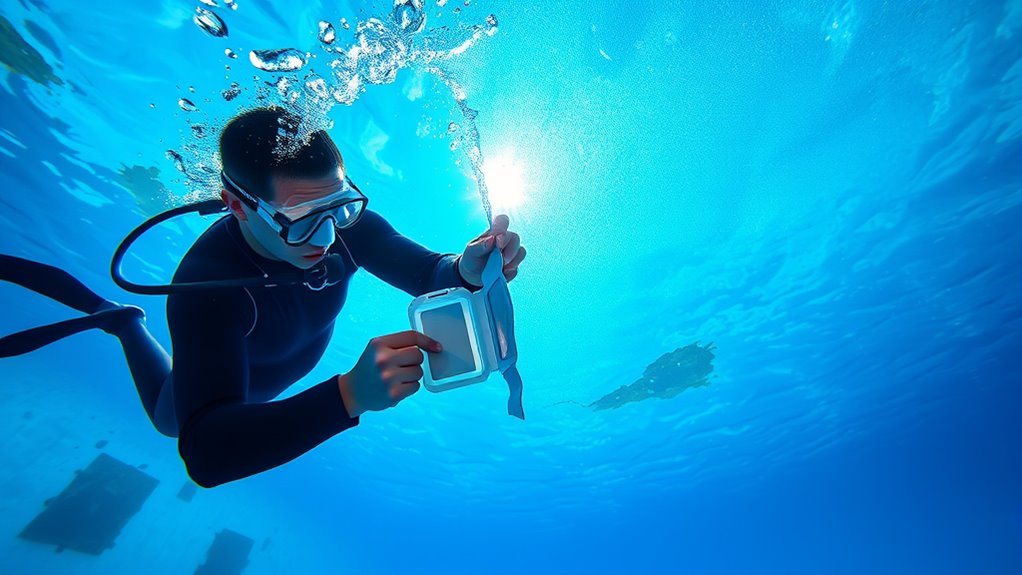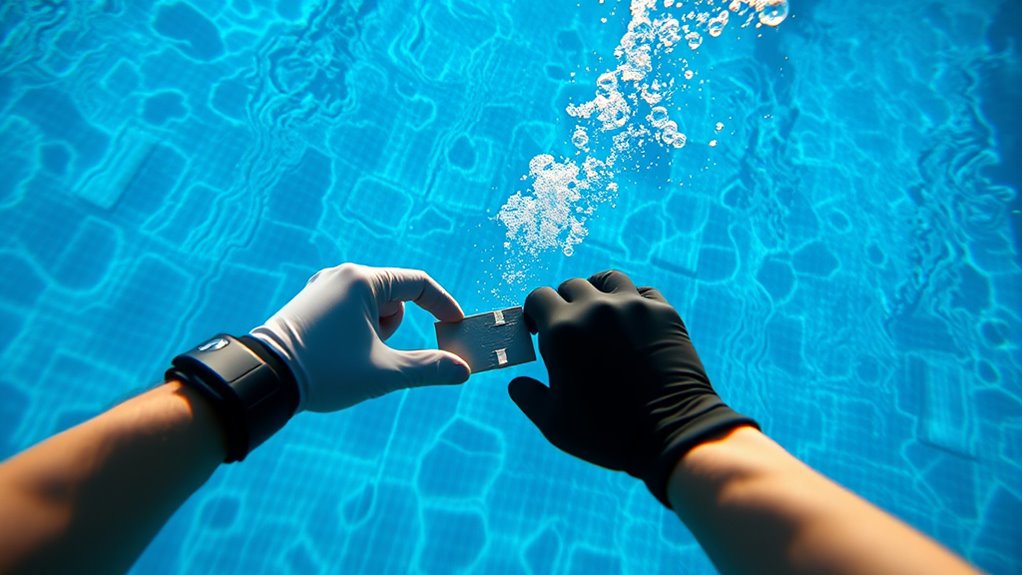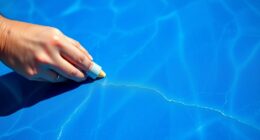To patch above-ground pool liners underwater, start by turning off your pump and filter, then dry the area thoroughly. Carefully cut a patch that overlaps the tear and apply a bonding agent if needed. Press the patch firmly in place, holding it for several minutes to guarantee adhesion. Allow at least 24 hours before reactivating your pump. Keep an eye on the repair to catch any leaks early—continue exploring for detailed tips to ensure a durable fix.
Key Takeaways
- Turn off the pool pump, dry the damaged area, and clean debris before applying an underwater patch.
- Select a compatible underwater patch kit designed for above-ground liners; cut the patch with a slight overlap.
- Carefully position and press the patch onto the tear, ensuring no air bubbles, and follow bonding agent instructions.
- Hold the patch steady for several minutes, then wait at least 24 hours before reactivating the pump and filter.
- Regularly monitor the repaired area for leaks and maintain proper adhesion to ensure a long-lasting fix.

If your above-ground pool liner develops a tear or hole, repairing it underwater can save you time and money. Instead of draining the entire pool, you can patch the damage while the water remains inside, allowing you to continue enjoying your pool without lengthy downtime. However, this process requires careful attention to pool maintenance and safety precautions to ensure a successful repair. Before you begin, make sure you have all the necessary tools and materials, including a reliable underwater patch kit, a clean cloth, and possibly a bonding agent designed for pool liners.
Repair your above-ground pool liner underwater to save time and avoid draining the pool.
First, assess the size and location of the tear. Small punctures or tears near the water’s surface are easier to repair than large or deep ones. To maintain safety, turn off the pool’s pump and filter system before starting. This prevents debris from circulating and helps you get a clear view of the damage. Use a clean cloth to gently dry the area around the tear, removing any algae, dirt, or moisture that could interfere with the patch’s adhesion. Keep in mind that proper pool maintenance includes regularly inspecting your liner for early signs of wear and tear to prevent more significant issues later on.
When applying the patch, follow the instructions provided with your underwater repair kit meticulously. Typically, you’ll need to cut the patch to size, ensuring it covers the tear with a slight overlap. Carefully position the patch over the damaged area, pressing firmly to eliminate air bubbles and ensure good contact with the liner. Some patches require a bonding agent; if so, apply it evenly before placing the patch. Once in place, hold the patch steady for a few minutes to allow it to adhere properly. Using proper adhesion techniques can significantly increase the longevity of your repair.
Throughout this process, safety precautions are essential. Avoid rushing, as improper application can lead to the patch failing underwater. Be cautious of slippery surfaces around the pool, and wear appropriate footwear to prevent falls. Also, ensure the pool’s electrical equipment is turned off to minimize any risk of electric shock. After completing the repair, wait at least 24 hours before turning the pump and filter system back on to allow the patch to set fully. Keep an eye on the repaired area over the next few days to confirm the patch remains secure and the tear doesn’t reappear.
Frequently Asked Questions
Can I Patch My Pool Liner Without Draining the Water?
You can patch your pool liner without draining water, but you must prioritize safety precautions and maintain proper pool chemistry. Make certain the water level stays below the patch area, and follow the patching kit instructions carefully. Keep the water clean and balanced to prevent algae or bacteria growth. Always work in well-ventilated areas, wear gloves, and avoid patching underwater if you’re unsure about the process, to guarantee a secure repair.
What Tools Are Best for Underwater Patching?
You’ll want a durable underwater patch kit, including a vinyl patch, adhesive, and a roller for proper tool selection. Use a clean, sharp utility knife to trim any rough edges around the tear. For effective patching techniques, thoroughly dry the area and apply the adhesive evenly before placing the patch. A roller helps guarantee proper adhesion and eliminates air bubbles, giving you a secure, long-lasting repair underwater.
How Long Does an Underwater Patch Typically Last?
You might worry about underwater patch longevity, but with proper application, your patch can last up to 1-3 years. The durability of your pool liner and the quality of the patching materials greatly influence how long it stays effective. Regular maintenance and avoiding sharp objects can extend this lifespan. Ultimately, a well-applied patch provides reliable repair, ensuring your pool stays functional and safe for seasons to come.
Are There Specific Patching Products for Different Liner Materials?
Yes, there are specific patching products for different liner materials to guarantee patch compatibility. You should choose patches made for vinyl, PVC, or other liner types you have. Always check the product label to confirm it works with your liner material. Using the right patch ensures a secure, waterproof repair that lasts longer. Matching patch material to your liner is essential for effective underwater repairs and durability.
Is Professional Help Necessary for Underwater Patching?
You don’t necessarily need professional help for underwater patching, but it’s advisable if you’re unsure about pool chemical compatibility or unfamiliar with underwater patch techniques. With proper technique, you can successfully patch your liner, but professionals ensure the repair is durable and leak-proof. They also handle tricky situations, like complex tears or chemical reactions, giving you peace of mind and saving time, especially if you want a quick, reliable fix.
Conclusion
Remember, a stitch in time saves nine. Patching your above-ground pool liner underwater might seem tricky, but with patience and the right approach, you can fix small tears effectively. Don’t wait until the problem worsens—address small leaks early to prevent bigger headaches later. Stay attentive to your pool’s condition, and you’ll keep it in great shape all season long. With care and prompt action, your pool will stay inviting and enjoyable for everyone.








